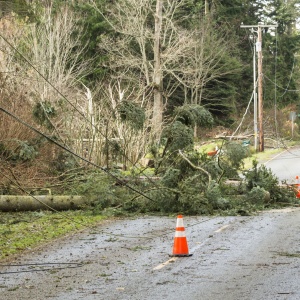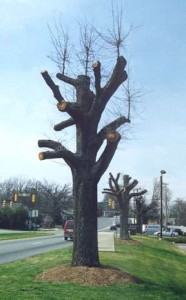Mukilteo’s beauty is largely attributed to our waterfront and our massive green spaces. They play a significant role in creating the high quality of life we enjoy. Trees are also a valuable resource that provide a variety of public benefits to the community such as stormwater retention, improving water quality, stabilizing slopes, and creating wildlife habitat.
Before You Plant:
Wise tree selection and placement of newly planted trees also protect street and sidewalk visibility and clearance and prevent damage to pavement, sewers, and buildings. Properly located trees can greatly enhance property appearance leading to greater value and could be considered an investment in the future. Consider planting with native species that are adaptable to our climate, conserve water, and provide much-needed habitat for local birds and animals.
When making tree and shrub decisions, consider how you want your yard/property to look in 20 years.
- Are there power lines near or above the location of the tree?
- Does the type of tree have the capacity to grow taller than the power/utility lines?
- Are there underground utilities that serve your home and have you located them to avoid damage?
- Is the tree considered an invasive species (i.e., poplars and willows) that could develop large tree roots and cause serious damage to sewer pipes and other underground utilities?
- Will the tree be planted too close to sidewalks or driveways whose roots will cause the pavement to “heave” as they mature? Repairs to concrete are expensive and are a trip hazard for pedestrians.
- Will the tree be planted too close to buildings and/or homes that can damage the roof or foundation?
Trees Planted Near Power Lines:

A large number of power outages affecting Snohomish County in recent years were caused by trees. Fallen trees and tree limbs that become entangled in lines, wind-blown branches that cross lines as they fall to the ground and tree limbs that grow into power lines are the major causes of outages, according to the Snohomish County PUD’s Tree Book, A Tree Selection Guide for Planting Near Power Lines. This publication was prepared to provide utility customers with guidelines for appropriate tree selection, placement, and management so that trees planted will result in many years of beauty and safety.
Routine Inspection of Trees:
Inspect your trees regularly, especially at the beginning of storm season. Learn to spot the eight warning signs of structure tree defects:
- Tree care history and maintenance
- Excessive lean (i.e., the tree is no longer vertical but leaning one way or another)
- Multiple trunks
- Weakly attached branches
- Cavities/deep pockets
- Cracks in trunk or limbs
- Hangers (broken limbs in the trunk)
- Deadwood
Need to Trim or Remove a Tree?
First, find out if the tree is located in the right-of-way, on City-owned property, or on a privately-owned property by using the City of Mukilteo Parcel Viewer Map.
For information about certified arborists, visit the International Society of Arboriculture, Pacific Northwest Chapter.
Trees Planted Near Power Lines
Remove anything away from a potentially hazardous tree immediately; call the PUD at (425) 783-5579 to request an examination by a certified arborist.
Trees in the Public Right-of-Way or on City Property
The City does not permit private parties to trim or remove trees in the public right-of-way or on City-owned property. Either City staff or a qualified contractor hired by the City will complete this work. For work on City-owned property, staff typically notifies adjacent property owners if time permits.
If you see a tree that appears to be dead, dying, or hazardous, please fill out the Fix It! Public Works Form or call City Hall at (425) 263-8000. Once the service request is started, members of the Public Works Department and Planning Department will follow up with you.
If you see trees being trimmed or removed on City-owned property by someone other than City staff or a City contractor, please report the activity to the non-emergency line at (425) 407-3999.
Trees on your Property UPDATED January 20, 2022
If you are seeking permission to remove a tree, please:
- NEW Submit a tree removal request using our Online Permit Portal.
- Sign up for an account.
- From the main page, select “Apply Online”, then “Planning Category”, and then “Tree Removal Request”.
- You will need:
- The number of trees proposed for removal;
- Photos of the property to show where the tree is located in relation to structures; and
- Photos the tree itself.
- If you are using a contractor, they will need a valid State Business License with a City of Mukilteo Business License Endorsement, and a valid State Contractor’s License that allows them to complete tree removal (Washington Labor & Industries Verify a Contractor Website).
- Email the Permit Center if you need assistance.
We are currently receiving a significantly higher volume of tree requests than normal – please give us five (5) business days to respond to your initial request and an additional few weeks for an answer.
Please note that trees located in or near a critical area may be subject to additional requirements, including review by a certified arborist or licensed geotechnical engineer. You can find critical areas information for your property in the City of Mukilteo Critical Areas Map.
Methods to Trim Trees

Topping: Do Not Top Trees. Tree topping is the practice of cutting large branches in mature trees into stubs or lateral branches or the entire removal of large branches. Other names for topping include “stubbing”, “heading”, “tipping”, “hat-racking” and “rounding over.” Whatever the name, it’s still a bad idea.
According to the International Society of Arboriculture, topping is perhaps the most harmful tree pruning practice known. Yet, despite more than 25 years of literature and seminars explaining its harmful effects, topping remains a common practice.
Tree topping:
- Causes stress, which makes the tree more vulnerable to insect and disease infestations;
- Leads to decay;
- Allows trees to be sunburned which causes cankers, bark splitting and death of some branches;
- Creates hazards from the newly grown shoots which are prone to breaking, especially during windy conditions;
- Is expensive because topped trees require frequent high-maintenance pruning practice (as often as annually while untopped trees only require infrequent pruning); and
- Destroys the natural form of the tree which creates poor aesthetics for the neighborhood.
Thinning: Retaining the natural form of the tree by removing foliage evenly throughout the canopy to create a filtered view through and beyond the foliage. Care must be taken not to remove too much foliage (less than ¼ of the total canopy) in order to avoid sucker growth.
Windowing: A pruning technique that involves selectively removing branches to allow a full view through the tree, similar to looking through a keyhole to a view beyond.
Skirting: A pruning technique where the lower branches of a tree are removed in order to achieve a view looking under the foliage. In order to make sure the tree remains healthy, it is important not to over-do branch removal. No more than 1/3 of the tree’s total height in branches should be removed.





